Southwell Minster
| Southwell Minster | |
|
Cathedral and Parish Church of | |
|---|---|
|
Southwell, Nottinghamshire | |
| Status: | Cathedral |
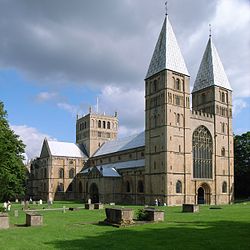 Southwell Minster | |
| Church of England | |
| Diocese of Southwell and Nottingham | |
| Location | |
| Grid reference: | SK70185378 |
| Location: | 53°4’36"N, -0°57’14"W |
| History | |
| Built c.1108-c1300 | |
| Romanesque, Gothic | |
| Information | |
| Website: | southwellminster.org.uk |
Southwell Minster ˈsʌðəl is the cathedral for the Diocese of Southwell and Nottingham and the seat of the Bishop of Southwell and Nottingham. It stands in Southwell in Nottinghamshire, six miles from Newark-on-Trent and thirteen miles from Mansfield.
From its foundation in 1884 until 2005, the diocese was known simply as the Diocese of Southwell. Since the creation of the Diocese of Derby, the diocese covers just Nottinghamshire.
History
Middle Ages
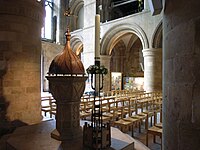
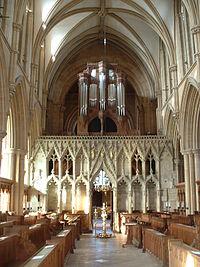
The earliest church on the site is believed to have been founded in 627 by Paulinus, the first Archbishop of York, when he visited the area while baptising believers in the River Trent. The legend is commemorated in the Minster's baptistry window.[1]
In 956 King Eadwig gave land in Southwell to Oskytel, Archbishop of York, on which a minster church was established. The Domesday Book of 1086 recorded the Southwell manor in great detail. The Norman reconstruction of the church began in 1108, probably as a rebuilding of the pre-conquest church, starting at the east end so that the high altar could be used as soon as possible and the Saxon building was dismantled as work progressed. Many stones from this earlier Anglo-Saxon church were reused in the construction. The tessellated floor and late 11th century tympanum in the north transept are the only parts of the Saxon building remaining intact. Work on the nave began after 1120 and the church was completed by c.1150.
The church was originally attached to the Archbishop of York's Palace which stood next door and is now ruined. It served the archbishop as a place of worship and was a collegiate body of theological learning, hence its designation as a minster. The minster draws its choir from the nearby school with which it is associated.
The Norman chancel was replaced with another in the Early English style in 1234 because it was too small. The octagonal chapter house, built in 1286 with a vault in the Decorated Gothic style has naturalistic carvings of foliage (the 13th-century stonecarving includes several Green Men). The elaborately carved "pulpitum" or choir screen was built in 1350.
Reformation and Civil War
The church suffered less than many others in the Reformation as it was refounded in 1543 by Act of Parliament.
Southwell is where King Charles I was captured during the Civil War. The fighting saw the church seriously damaged and the nave is said to have been used as stabling. The adjoining palace was almost completely destroyed, first by Scottish troops and then by the local people, with only the hall of the Archbishop remaining as a ruined shell. The Minster's financial accounts show that extensive repairs were necessary after this period.
18th century
On 5 November 1711 the southwest spire was struck by lightning, and the resulting fire spread to the nave, crossing and tower destroying roofs, bells, clock and organ.[2] By 1720 repairs had been completed, now giving a flat panelled ceiling to the nave and transepts.
Victorian
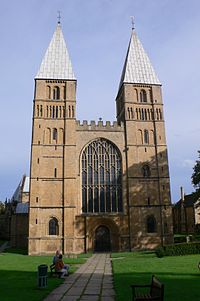
In 1805 Archdeacon Kaye gave the Minster the Newstead lectern; once owned by Newstead Abbey, it had been thrown into the Abbey fishpond by the monks to save it during the Dissolution of the Monasteries, but discovered only when the lake was dredged in the nineteenth cetiury.[3] Sir Henry Gally Knight in 1818 gave the Minster four panels of 16th-century Flemish glass (which now fill the bottom part of the East window) which he had acquired from a Parisian pawnshop[4]
In danger of collapse, the spires were removed in 1805 and re-erected in 1879–1881 when the minster was extensively restored by Ewan Christian, an architect specialising in churches. The nave roof was replaced with a pitched roof[5] and the choir was redesigned and refitted.
Ecclesiastical history
Collegiate church
Southwell Minster was served by prebendaries from the early days of its foundation. By 1291 there were 16 Prebends of Southwell mentioned in the Taxation Roll.
In 1540 the prebends and minster were suppressed but an act of Parliament in 1543 re-established the college and church collegiate of Southwell. Under an Act of King Edward VI, the prebendaries were given pensions and their estates sold. The minster continued as the parish church on the petitions of the parishioners.
By an Act of Philip and Mary in 1557, the minster and its prebends were restored.[6] On 2 April 1585 a set of statutes was promulgated by Queen Elizabeth I and the chapter operated under this constitution until it was dissolved in 1841. The Ecclesiastical Commissioners made provision for the abolition of the chapter as a whole; the death of each canon after this time resulted in the extinction of his prebend. The chapter came to its appointed end on 12 February 1873 with the death of the Rev Thomas Henry Shepherd, rector of Clayworth and prebendary of Beckingham.[7]
Cathedral
In 1884 Southwell Minster became a cathedral, for a new Diocese of Southwell serving Nottinghamshire and Derbyshire. George Ridding, the first Bishop of Southwell, designed and paid for the grant of Arms now used as the diocesan coat of arms. The diocese was divided in two in 1927 with the creation of the Diocese of Derby, leaving Southwell with just its home county, Nottinghamshire. The diocese's centenary in 1984 was commemorated by a royal visit to hand out Maundy money.
Southwell is on occasion referred to as a city by the popular tradition, that a city is a town with a cathedral, but no letters patent to that effect have been issued and the county's only city remains Nottingham.
The Friends of Cathedral Music was founded in 1956 by the Revd Ronald Sibthorpe prompted by a decision of the provost to abolish Saturday choral evensong so that lay clerks could watch football at Newark-on-Trent.[8]
Architecture
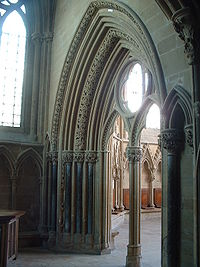
The nave, transepts, central tower and two western towers of the Norman church which replaced the Saxon minster remain as an outstanding achievement of severe Romanesque design. The central tower's two ornamental stages place it high among England's surviving Norman towers. The nave is imposing, with cylindrical columns, large triforium arches and an unaltered clerestory with rows of round windows.[9]
The choir is Early English in style. In the 14th century the choir screen and the chapter house were added. The polygonal chapter house and its vestibule comprise a Decorated masterpiece with sculptured detail including heads and naturalistic foliage, the latter being unsurpassed in Britain. There is the tomb of Archbishop Sandys of York (died 1588).[9]
Staff
The cathedral is staffed by the Dean of Southwell, a Canon Pastor and a Canon Precentor, who make up the "Dean and Chapter". It also has a Priest Vicar, a Canon Theologian, the Bishop's Chaplain and the Chaplain to the Minster School.
Lay staff include the Rector Chori, Assistant Director of Music, Organ Scholar, Head Verger and the choristers.
Music and liturgy
Much of the worship at the minster is led by the Cathedral Choir, a traditional choir of boys and men, directed by the Rector Chori ("The Ruler of the Choir"). Choristers are educated at the Minster School, which is unusual among choir schools as it is in the state sector. The choir attracted some international attention when previous head chorister Ben Inman, formed The Choirboys, a "boy band" comprising three cathedral choristers. There is a girls' choir and the adult Minster Chorale. The minster follows the rites of the Church of England and uses the 1662 Book of Common Prayer for Choral Eucharist on Sunday.
Choirs
In recent years, the choir has broadcast on BBC Radio 3, recorded CDs, toured in Europe, filmed Christmas programmes, and given world premières of specially commissioned works such as Paul Patterson’s Southwell Millennium Mass. The choir has appeared before Her Majesty the Queen, sung with the Royal Philharmonic Orchestra, the Orchestra of St John's, Smith Square and the London Festival Orchestra. In 2003 the Minster Choir joined the choirs of Westminster Cathedral and St Albans Cathedral for a concert in the St Albans International Organ Festival. Former Prime Minister Sir Edward Heath, a classical pianist himself, wrote "I cannot recall a more impressive programme of church music in many recent years. My deepest congratulations for an evening the richness of which will last for ever".
Gallery
-
Stonework
-
The Presepe Window
-
INRI
-
Window
-
the Interior
-
One of the misericords in the quire
Outside links
| ("Wikimedia Commons" has material about Southwell Minster) |
- Southwell Minster
- Southwell Minster Virtual Tour
- Details and pictures of the screen organ from the National Pipe Organ Register
- Details of the nave organ from the National Pipe Organ Register
- Guide to Southwell Minster with a History of the College of Secular Canons, Grevile Mairis Livett, Printed by John Whittingham, Southwell, 1883
References
- ↑ Daniel Defoe's Tour Through the Whole Island of Great Britain, 1726
- ↑ The Cathedral Church of Southwell by Arthur Dimock
- ↑ English cathedrals, Patrick Cormack
- ↑ Collins guide to cathedrals, abbeys, and priories of England and Wales. Henry Thorold.
- ↑ Transactions of the Thoroton Society of Nottinghamshire: Volumes 76-77, 1973
- ↑ Notts Villages. W. E Doubleday, as published in The Nottinghamshire Guardian.
- ↑ 'Colleges: The collegiate church of Southwell', A History of the County of Nottingham: Volume 2 (1910), pp. 152-161.
- ↑ Barrett 2010
- ↑ 9.0 9.1 Little, Bryan (1972). English Cathedrals in Colour. London: Batsford. pp. 140–43.
- Nikolaus Pevsner (1945) The Leaves of Southwell; photographs by F L Attenborough. (King Penguin Books; 17.) Harmondsworth: Penguin Books
| Cathedrals of the Church of England |
|---|
|
Province of York:
Blackburn •
Bradford •
Carlisle •
Chester •
Durham •
Liverpool •
Manchester •
Newcastle upon Tyne •
Peel •
Ripon •
Sheffield •
Southwell •
Wakefield •
York
|







